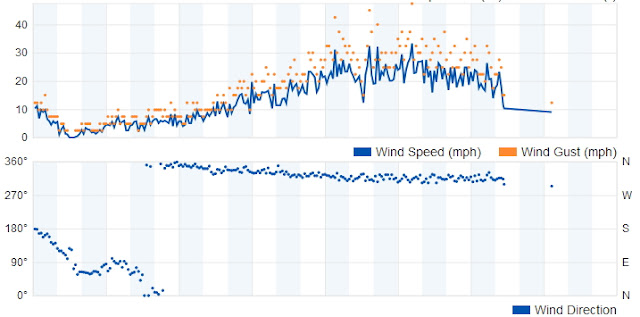My solar power system is grid intertied. This means that I have no battery backup and the solar inverters shut down to prevent back feeding power into the grid in an outage. This could harm line workers as they restore power and is a federally mandated safety system built into all grid connected solar equipment.
So I have 2 meters. One that records incoming energy from the utility (the use meter), and the other records surplus energy that I export to the grid (generation). My solar power offsets my usage, and in the summer and fall I generate more than I use so the utility credits me for the power I put into the grid. The credits accumulate and I use them up in the late fall to cover a month or 2 of bills.
A lot of people assume that because I have solar I have power during an outage. I don't. I had 2 options when I built my system in 2009 - battery backup or an automatic standby generator. The cost and maintenance of a battery bank would be prohibitive and it would not work well with the micro-inverters that I used. Back then the only option was lead-acid batteries that were either flooded (filled with liquid acid) that require constant maintenance, or more expensive sealed batteries know as AGM (absorbed glass mat) batteries. Nowadays lithium batteries are more common - like the Tesla Powerwall. But that is also pricey and does not provide as much storage as I would like.
So I elected to install a Generac Guardian automatic backup generator powered by propane. This unit starts within 15 seconds of an outage and is pretty reliable, as long as I do basic maintenance. I already had a propane backup boiler for my solar heating system, so I had a propane storage tank right near my utility room. I got mine from Home Depot for $2500 and installed it myself. It cost less than half the cost of a modest battery bank that would be sufficient for my needs. With a full tank (actually 2 tanks) of propane I can run for over 2 weeks on the generator and often need it for days at a time when we get big winter storms. The generator does not power everything on my property, just the essential loads, so it can't charge my electric car and I can't run my table saw or wood lathe - both are big 240V machines!
I installed an hour meter for my generator in a box with 2 lights that indicate where my power is coming from and use this to record how long each outage is.
This last winter was brutal with 11 outages ranging from an hour to over 2 days. We had a lot of hard wind storms with gusts topping out at over 45MPH as recorded on my weather station. Yesterday (May 9, 2020) was a typical windy day that knocked power out for 10.5 hours. You can see that the wind gusts went off the chart at 50MPH! You can see where the power dropped out where the blue line goes flat at around 7:30pm.

Click on the image to see my live weather station.
Here's a list showing generator run times per outage we had over the winter and spring:
So clearly it's a Faustian bargain for me. Most of the time I'm using free and clean energy from the sun to power my home, workshop and Chevy Volt. But then I have to deal with dirty, expensive propane when the utility power drops out. I still think it's more cost effective than batteries. But someday I'd love to install more solar and battery power to go fully off the grid.





No comments :
Post a Comment
I welcome all thoughtful comments and feedback!